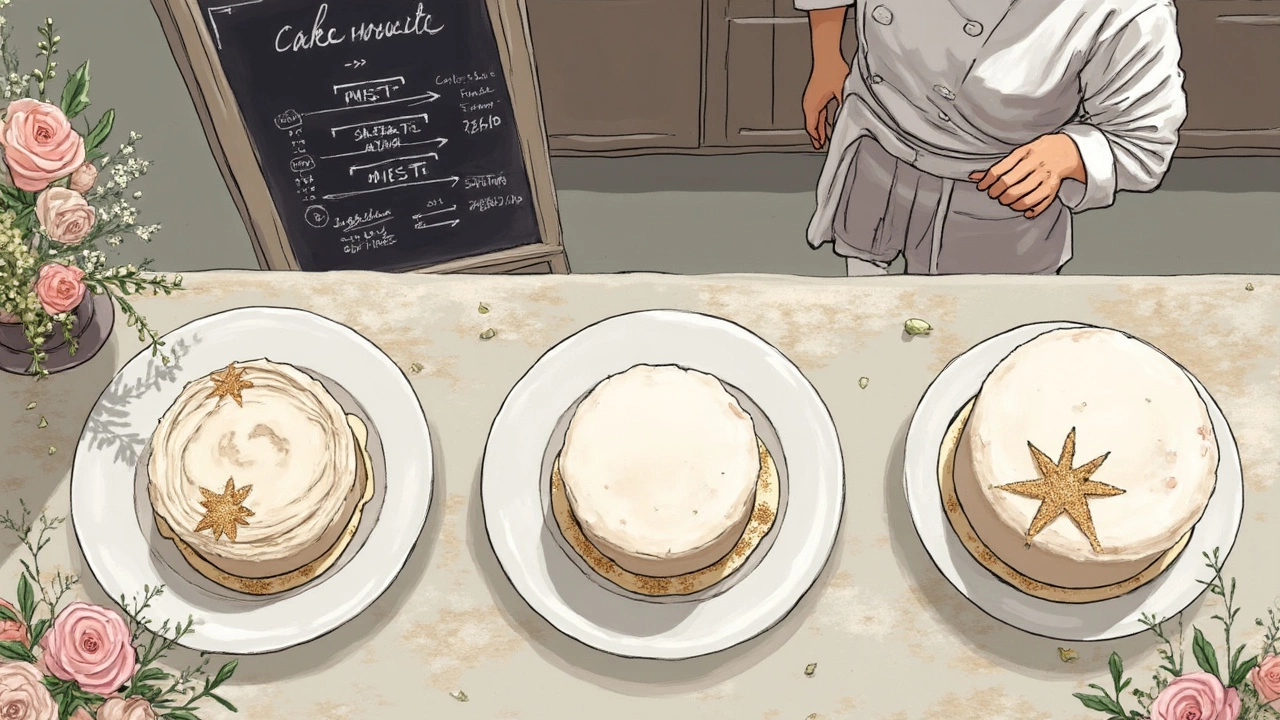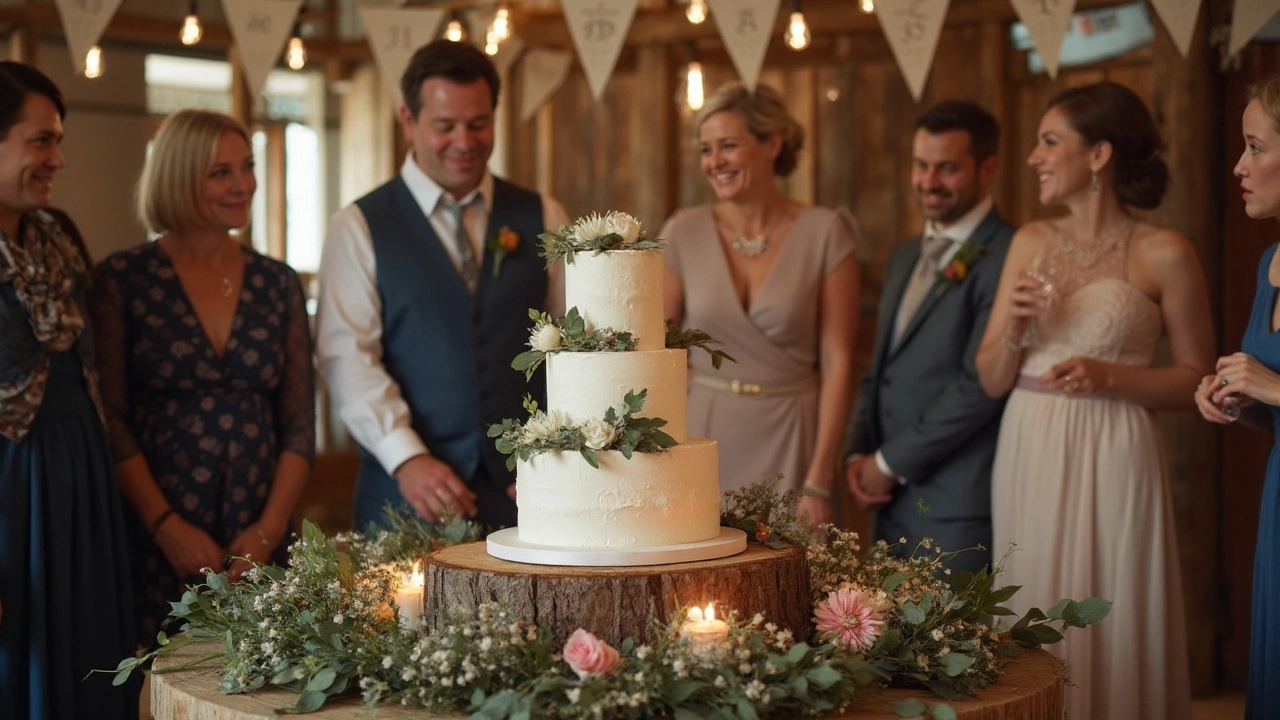Sizing a wedding cake that feeds 150 people can feel like you’re solving a puzzle. You can’t just order a huge cake and hope for the best—different shapes, tier heights, and serving styles totally change things. Wedding cake makers usually use a pretty specific serving chart to figure out exactly what you’ll need. A standard wedding cake slice is smaller than your classic birthday cake piece—think 1 inch by 2 inches. Sounds tiny, but with all the food and dancing, it’s just right.
If you want to keep things simple, a three-tiered cake (for example, 6-inch, 10-inch, and 14-inch round tiers) gives you about 128-148 servings, depending how you cut it. It’s tempting to go bigger just in case, but nobody wants to waste cake. If you expect your guests will want seconds, or if you plan to save the top tier for your anniversary, let your baker know up front. They’ll help you tweak the numbers so everyone gets a slice and nothing goes to waste.
- Understanding Cake Serving Sizes
- Choosing the Right Cake Shape and Tiers
- Popular Cake Combinations for 150 Guests
- Money-Saving Tips and Tricks
- Extra Tips on Serving, Allergies, and Cake Leftovers
Understanding Cake Serving Sizes
If you’ve ever been stuck staring at a cake chart wondering how much is enough, you’re not alone. When it comes to wedding cake size, the numbers really matter. Most cake makers go by the standard wedding slice size: 1 inch wide, 2 inches deep, and 4 inches tall. It might look small next to a slice of birthday cake, but these pieces are actually designed so guests can enjoy dessert without getting stuffed or wasting food.
Here’s the part most people miss: the serving size counts on the cake being cut the exact right way. That means neat slices (no chunky wedges or random pieces). Bakers and caterers often have a diagram to follow, making sure every guest gets the same-sized piece and the cake for 150 guests is just the right fit.
"The biggest shock for couples? How much smaller a ‘wedding serving’ is compared to what you slice at home. Most of our couples are relieved when they see it’s the perfect amount with everything else on the menu." – Mia Jenner, SugarMoon Cakes
To give you a numbers breakdown, check out how different cake sizes stack up:
| Cake Round Diameter | Average Servings (4" height) |
|---|---|
| 6 inch | 12 |
| 8 inch | 24 |
| 10 inch | 38 |
| 12 inch | 56 |
| 14 inch | 78 |
Most bakers use a mix of tier sizes to reach the cake for 150 guests mark. If you mix shapes—like round, square, or even hexagon tiers—the servings change. One baker trick: square cakes usually give a few extra slices per tier than rounds of the same diameter. So if you want to be sure there’s enough for everyone, always ask for your baker’s serving chart.
Choosing the Right Cake Shape and Tiers
Picking the right shape and number of tiers is where the cake fun really starts. For a crowd of 150, you’ll need to think about more than just looks. Different shapes pack different serving numbers. Round cakes are the most popular for weddings—they’re classic and pretty simple for bakers to cut and stack. But square cakes surprise a lot of people because they actually give you a few more servings at the same size. That’s handy for stretching your budget.
Here’s a quick look at how serving sizes stack up by tier and shape for wedding cakes:
| Shape & Size | Servings (approx.) |
|---|---|
| 6" + 10" + 14" Round (3-tiers) | 128-148 |
| 6" + 8" + 10" + 12" Round (4-tiers) | 150-180 |
| 6" + 10" + 14" Square (3-tiers) | 150-170 |
If you’re set on a certain look—like those dramatic "tall and skinny" cakes—ask your baker about double-height tiers. They look impressive in photos but don’t actually increase the number of wedding cake servings unless you add extra cake layers inside. Some couples opt for extra height by sneaking in a fake tier made of foam. No one will ever know, and you’ll save some money.
Think about your guest list, too. If you’ll have a ton of kids or folks who aren’t big dessert eaters, you might get away with a cake that technically serves a little less than 150—especially if you’re also serving desserts like cupcakes or a candy bar. If cake is the main event, round up instead of down. And always chat with your wedding cake maker about your priorities—they can help you adjust tier sizes so you don’t wind up with a cake that’s way too small (or a fridge packed with leftovers).

Popular Cake Combinations for 150 Guests
If you want your wedding cake size to actually fit your guest count, here’s where the real number crunching happens. Most wedding cake makers suggest going with at least three tiers for a party of 150, but the specific tier sizes matter way more than just the count. A well-chosen combo will hit your number right on the nose—no waste, no shortage.
For round cakes, these are the most tried-and-true combos designed to cover about 150 servings:
- 6-inch, 8-inch, 10-inch, and 12-inch tiers (about 150 servings)
- 6-inch, 9-inch, 12-inch, and 14-inch tiers (around 160 servings, a bit extra just in case)
- 8-inch, 10-inch, and 14-inch tiers (gets you close to 148 servings with tall tiers—perfect if you want a bit more height)
Square cakes actually give you more slices per tier than rounds. That means you get more mileage from the same cake size. Here’s a quick comparison:
| Tier Sizes | Round Cake Servings | Square Cake Servings |
|---|---|---|
| 6" + 8" + 10" + 12" | about 130 | about 150 |
| 8" + 10" + 12" + 14" | about 195 | about 220 |
If you’re only a slice or two short (say your combo covers 140 and you have 150 guests), bakeries can whip up a small kitchen cake—an extra undecorated layer in the back that nobody sees, but which bumps up your serving tally for less money. This trick is crazy popular for big crowds.
Want to shake things up? Some couples add sheet cakes in the kitchen, letting them keep their “photo cake” on the smaller side for style, but still cover every guest without busting the budget. Sheet cakes usually match the main cake flavors, so no one feels left out.
Whichever tier combo you choose, always talk to the baker about exactly how many servings a given size will give based on their own servings chart—every bakery can have slightly different numbers, especially for tall or skinny tiers.
Money-Saving Tips and Tricks
Worried about blowing your budget on a massive wedding cake size for 150 guests? No shame in being thrifty—wedding costs add up fast. A few tried-and-true hacks can seriously help you cut costs without looking cheap.
- Go faux for the show: Lots of couples order a small, decorated cake for display (and those Insta pics) and have a big kitchen sheet cake in the back. Sheet cakes are way cheaper and guests won’t know the difference once it’s sliced in the kitchen.
- Keep it simple with design: Fancy fondant, sugar flowers, or gold leaf details all bump up the price. More basic buttercream styles or minimal toppers look classic and save money.
- Use fewer flavors: Swapping tons of cake flavors and fillings for just one or two keeps costs and mistakes down. Some bakers even charge extra for multiple flavors within one order.
- Cut down on delivery fees: Ask your venue if they allow pickup, or check if bundling set-up with other wedding vendors saves on extra charges.
- Go for shorter tiers: Tall tiers mean more cake and more to pay for. You can get just as much cake for 150 guests with standard, shorter tiers stacked up.
Bakers are honest about what drives costs. Like Rachel Smith from Sugar Rush Cake Studio puts it:
“There’s no rule that every guest has to see a five-tier cake at the reception. You’ll save big if you prioritize serving size and flavor over Pinterest inspiration photos.”
For perspective, here’s what different style cakes usually cost per serving in the U.S., so you know where the money goes:
| Type of Cake | Average Cost Per Serving |
|---|---|
| Buttercream basic cake | $4 – $6 |
| Fondant cake | $6 – $10 |
| Designer/decorated cake | $8 – $15 |
| Kitchen sheet cake (no decoration) | $2 – $4 |
Combine display tiers with kitchen cakes for the smartest savings. And always ask your baker where you can trim the fat—most will give you honest answers and love saving clients a buck or two.

Extra Tips on Serving, Allergies, and Cake Leftovers
Don’t let your wedding cake size planning go to waste at the last step—how you serve, store, and handle allergies matters just as much as picking the right cake tiers.
First, make sure whoever’s cutting and serving the cake knows what they’re doing. Professional venues have staff who slice wedding cake into neat, 1"x2" pieces, which gets you the right number of servings for your cake for 150 guests. If you’re asking a friend or caterer, show them a serving chart or quick video tutorial. Oddly shaped slices or oversized cuts will drain your cake supply way too fast.
Allergies can get tricky. Always talk with your baker ahead of time about common food allergies—nuts, gluten, dairy, and soy show up the most. Many bakers have nut-free or gluten-free options, but cross-contact can still happen if cakes are made in the same kitchen. If more than a handful of guests need special cake, think about ordering an extra, small allergy-friendly cake and label it clearly at the reception.
Nobody ever complains about too much cake, but leftovers need a plan. Wedding cake freezes better than you’d think. Wrap any extra slices tightly in plastic wrap, then pop them into freezer bags or containers. If you want to keep your top tier for your anniversary, ask your baker to box it up separately, or assign someone in your wedding party to save it before the cake is served.
Here’s a quick look at some expert serving facts and leftovers tips for a crowd this size:
| Tip | Why It Matters |
|---|---|
| Use the right size knife and server | Prevents crumbly slices and helps measure servings |
| Serve within 30–45 minutes after cutting | Keeps frosting fresh and cake moist |
| Label allergy-friendly options | Avoids any confusion or health scares |
| Freeze leftovers within 1–2 days | Best taste and texture for later |
| Let frozen cake thaw in the fridge | Prevents soggy frosting and icing damage |
If you do end up with more than you expected, send guests home with a slice or two in cute boxes. People love a late-night snack, and you get less cake in your freezer.

